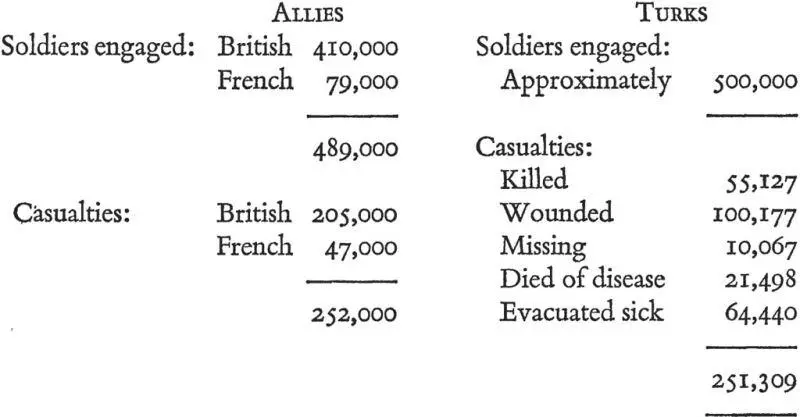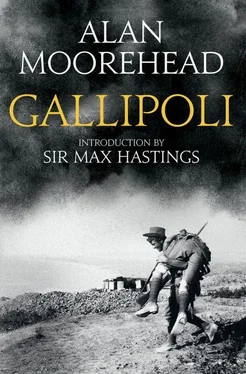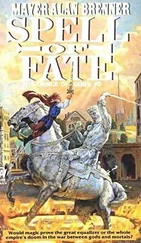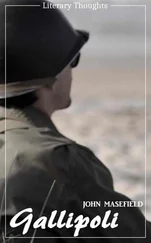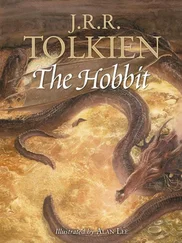Except once at Anzac when some barrels of wine were washed ashore from the wreck of the Triumph.
The men were issued, with a green active service envelope on which was printed, ‘I certify on my honour that the contents of this envelope refer to nothing but family matters.’ This meant that the letter was censored at the base and. not in the regiment.
For the laconic there was also a card with the printed words:
‘I am quite well.’
‘I have been admitted, to hospital, sick, wounded.’
One simply struck out the words that did not apply.
There were 24 British divisions in France at this time and only 4 in Gallipoli. The remainder of Hamilton’s force was made up of 2 French and 2 Anzac divisions — a total of 8 divisions.
Lone Pine had its name from the fact that the Turks, though supplied with charcoal for their cooking, had cut down for firewood all but a single tree on the ridge. It so happened that on the very morning of the attack this last tree was also felled.
Brilliant crimson oleanders, mistaken by the British for rhododendrons, were flowering there.
Field Marshal Sir William Slim, who subsequently became Governor-General of Australia, was one of the few young officers who, though severely wounded, survived the assault.
Carson resigned soon afterwards over the failure of the Government to send adequate help to Serbia. ‘The Dardanelles operations,’ he told the House of Commons, ‘hang like a millstone round our necks, and have brought upon us the most vast disaster that has happened in the course of the war.’
Hamilton had made a visit to Australia shortly before the war.
The proprietor of Ashmead-Bartlett’s newspaper the Daily Telegraph.
Churchill saw them off at dawn in London on October 22. As the train was drawing out of the station he threw a bundle of papers into Monro’s compartment and declared, ‘Remember that a withdrawal from Gallipoli would be as great a disaster as Corunna.’
Keyes had mentioned the scheme to Admiral Guépratte before he came to London, and Guépratte had said, ‘I think always of Nasmith. I think always of Boyle; if (thumping his chest) I were permitted to do this, I would think also of myself, moi, Guépratte.’
When this message arrived at Imbros at 2 a.m. the following morning the signals officer on duty began to decode it in the usual way. He stopped however, at the words ‘Decipher yourself’ and took the message to Colonel Aspinall. Aspinall then began decoding but baulked at the words ‘Tell no one’ and woke Birdwood. Birdwood, however, was unable to handle the cipher and Aspinall having been pledged to secrecy, finished the message for him by the light of a hurricane lamp.
Thousands of ducks were shot down, and it was said after the campaign was over, with how much truth one cannot know, that several years went by before the migrating birds settled again on Gallipoli.
A certain amount of winter clothing had been landed on the peninsula but it had been taken off again in view of the plans for evacuation.
Several ships were sunk to form breakwaters at this time, and on Imbros Admiral Wemyss even proposed to use an old battleship in this way. Eventually, however, he requisitioned a collier which had just steamed in from England with 1,500 tons of coal on board. The captain protested but down the ship went to the bottom. The vessel was pumped out after the evacuation and sailed away apparently none the worse for her immersion.
The incident inspired the exasperated embarkation officer to compose the following lines:
‘Come into the lighter, Maude,
For the fuse has long been lit.
Hop into the lighter, Maude,
And never mind your kit.’
An alternative version runs:
‘Come into the lighter, Maude,
For the night is nearly flown.
Come into the lighter, Maude,
And leave your bag alone.’
According to Liman von Sanders the booty at Cape Helles was enormous and took two years to gather up. Whole shiploads of conserves, flour and timber were sent to Constantinople.
On June 5, 1916, he sailed in the Hampshire on an official visit to Russia, and was drowned when the ship struck a mine off the Orkneys.
The official figures were:
